Special Report
Healthiest City in Every State

Published:
Last Updated:

The United States is one of very few economically powerful countries in the world that still does not have a fully central and universal health care system. Many other countries have guaranteed a certain standard and quality of care to all of its citizens, but in the United States health care outcomes are largely driven by regional and local factors. This means that health outcomes can vary significantly from state to state and even from city to city.
For instance, health outcomes in different parts of Texas are often vastly different from one another. The premature mortality rate, which measures deaths of people under 75, is 260.0 per 100,000 residents in the Austin-Round Rock metro area. The rate jumps to 488.1 premature deaths per 100,000 residents in Texarkana. For comparison, the nationwide premature mortality rate is 333.3 deaths per 100,000 people.
To determine the healthiest city in every state, 24/7 Wall St. reviewed several health indicators such as healthy behaviors, health outcomes, and availability of care for all U.S. metro areas. We constructed an index from these factors to determine the overall health of the residents in each metropolitan area.
Click here to see the healthiest city in every state.
Click here to see our detailed findings and methodology.

1. Daphne-Fairhope-Foley, Alabama
> Premature death rate: 361.3 (per 100,000 residents)
> Adult obesity rate: 27.4%
> People under 65 without health insurance: 10.1%
> Median household income: $56,732
Though the Daphne-Fairhope-Foley area is the healthiest city in Alabama, it still lags behind the country as a whole in several key areas. The metro area’s premature death rate, or the number of deaths before age 75 per 100,000 people, is 361 per 100,000 people. While this is the lowest in the state, and much lower than the 464 premature deaths per 100,000 statewide rate, it is above the national rate of 333.3 per 100,000.
A physically active lifestyle can be a critical component of overall health and better access to places for exercise can increase the likelihood of being physically active. Only 72.2% of Daphne-Fairhope-Foley residents have access to a place where they can get exercise, more than the 62.8% of Alabama residents, but nearly a dozen percentage points behind the U.S. rate of 84.0%.
[in-text-ad]

2. Fairbanks, Alaska
> Premature death rate: 311.6 (per 100,000 residents)
> Adult obesity rate: 28.1%
> People under 65 without health insurance: 10.3%
> Median household income: $77,328
Adults in Fairbanks, Alaska tend to feel healthier than adults statewide and nationwide. Just 11.5% of Fairbanks adults rated their health as fair or poor, compared to 13.7% of Alaskan adults and 15.0% of American adults overall.
Metro area residents good health compared to the state as a whole may be partially due to the high health insurance coverage in the metro area. Some 89.7% of Fairbanks adults under 65 have insurance, matching the national insured rate, but well above the state rate. Some 19.0% of Alaska residents under 65 lack health insurance.

3. Phoenix-Mesa-Scottsdale, Arizona
> Premature death rate: 298.7 (per 100,000 residents)
> Adult obesity rate: 25.951055572692%
> People under 65 without health insurance: 12.5%
> Median household income: $58,075
One of the least healthy habits, cigarette smoking has been linked to lung and heart disease, and Phoenix area adults are less likely to smoke than the typical American adult, which can have wide-reaching positive long-term effects on health. In the United States, 18.0% of adults report a smoking habit. In the Phoenix-Mesa-Scottsdale area, only 13.3% of adults smoke. The area’s smoking rate is just a bit lower than the smoking rate across Arizona of 14.0%.
Due in part to healthy habits, like a low smoking rate, premature death is less common in Phoenix than in any other Arizona metro area.
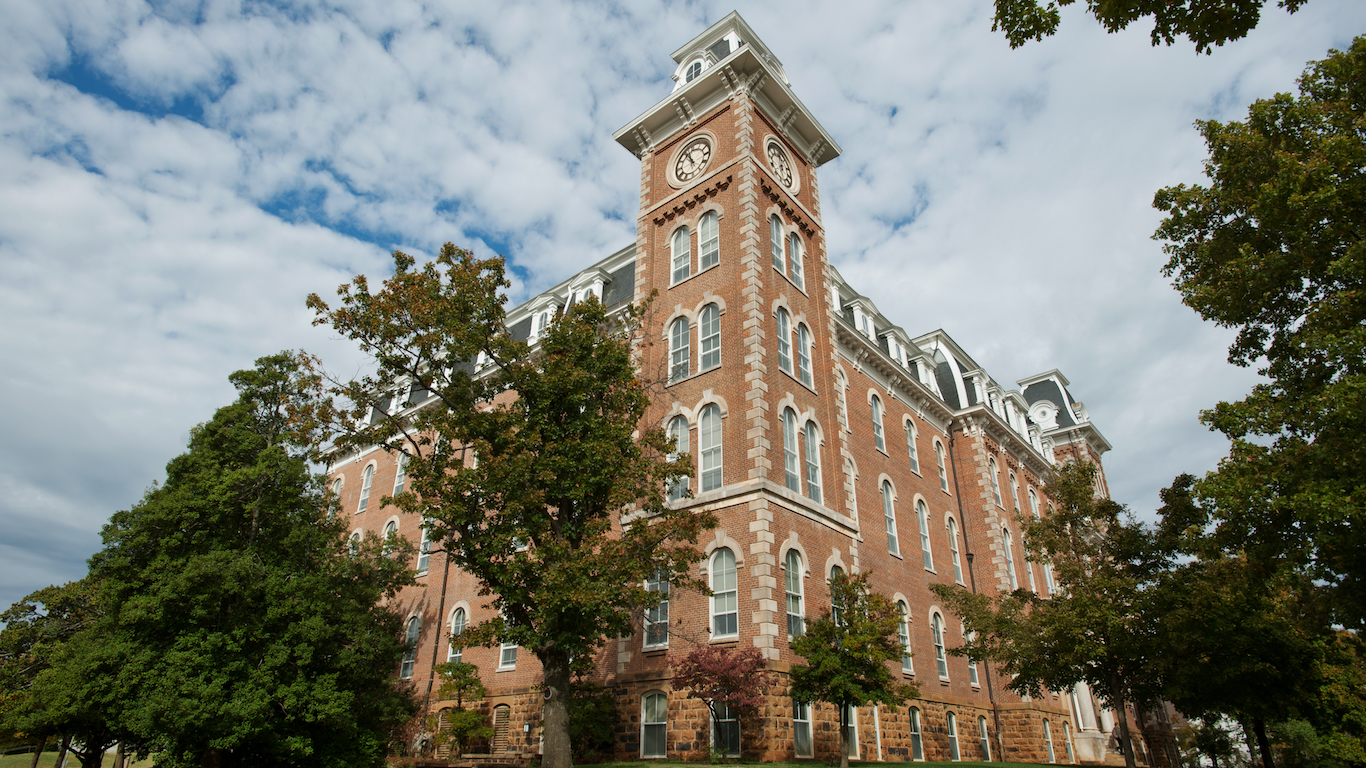
4. Fayetteville-Springdale-Rogers, Arkansas
> Premature death rate: 363.1 (per 100,000 residents)
> Adult obesity rate: 30.4%
> People under 65 without health insurance: 11.3%
> Median household income: $51,848
Arkansas is one of the least healthy states in the country, and even its healthiest metro area, Fayetteville-Springdale-Rogers, falls short of national averages in many health measures, including access to care. The area has 63.7 primary care physicians per 100,000 residents, below the U.S. average of 75.8 per 100,000. There is an even greater disparity for dentists. There are just 28.7 dentists per 100,000 residents in the area, less than half of the 65.8 per 100,000 ratio nationwide.
Likely due in part to a lack of access to care, and many other factors, 18.9% of adults in the Fayetteville metro area report being in fair or poor health, compared to the 15.0% who do nationwide. However, this is still the second smallest share of any metro area in Arkansas, and lower than the 22.7% share of adults statewide.
[in-text-ad-2]

5. San Jose-Sunnyvale-Santa Clara, California
> Premature death rate: 196.0 (per 100,000 residents)
> Adult obesity rate: 19.6%
> People under 65 without health insurance: 5.7%
> Median household income: $110,040
High earning areas often report better health outcomes than lower earning areas, and California’s healthiest metro area also happens to be its wealthiest. San Jose-Sunnyvale-Santa Clara median household income of $110,040 is the highest in both the state and the nation, which likely helps many in the area afford healthy lifestyles and top quality health care. The area’s premature death rate of 196.0 deaths of people before age 75 per 100,000 residents is far lower than the national premature death rate of 333.3 per 100,000 and the statewide rate of 268.6 premature deaths per 100,000.

6. Boulder, Colorado
> Premature death rate: 213.0 (per 100,000 residents)
> Adult obesity rate: 13.4%
> People under 65 without health insurance: 5.4%
> Median household income: $74,615
Boulder is not just the healthiest metro area in Colorado, but also one of the healthiest in the country by several measures. For example, just 13.4% of Boulder adults are obese, the smallest share of any U.S. metro area. The U.S. obesity rate is more than twice as high at 28.0%. Boulder also has the second lowest premature death rate in the nation at 213.0 deaths of people under age 75 per 100,000 people.
[in-text-ad]
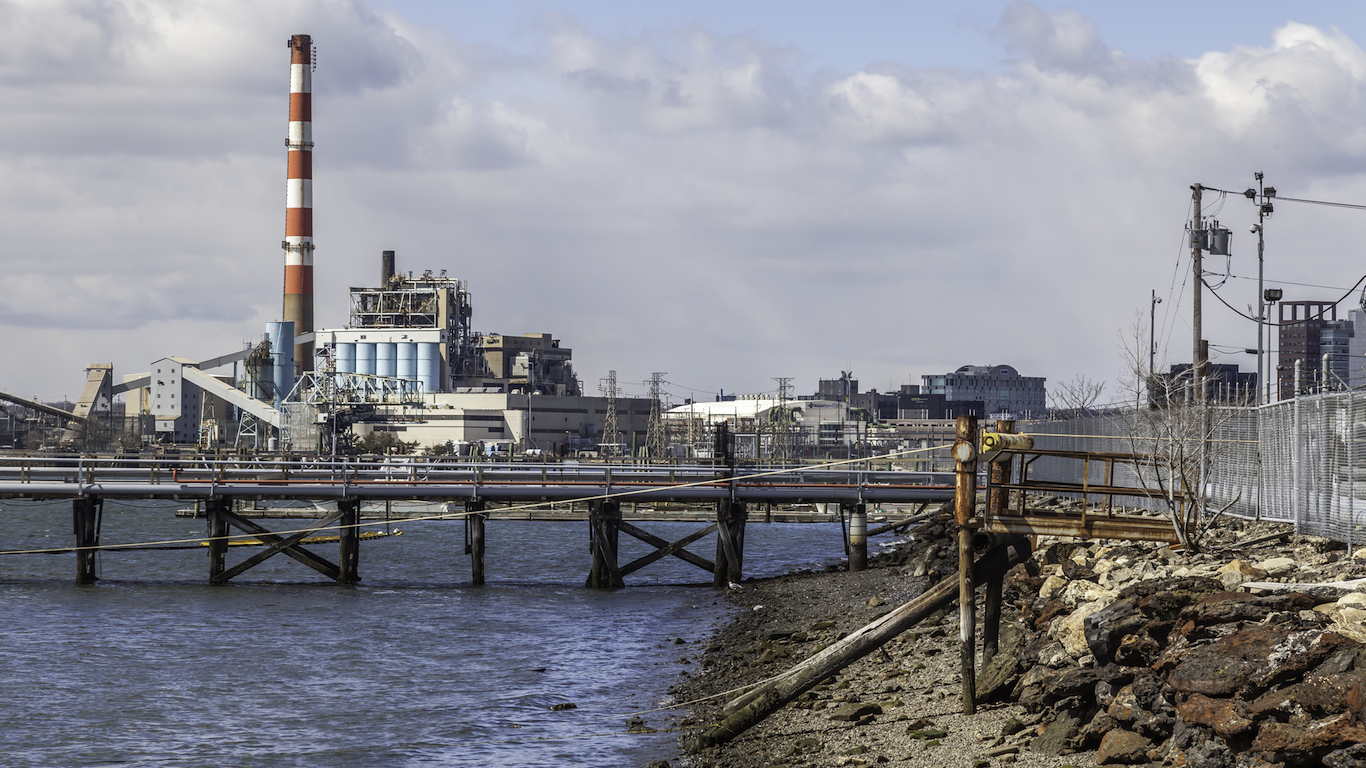
7. Bridgeport-Stamford-Norwalk, Connecticut
> Premature death rate: 217.0 (per 100,000 residents)
> Adult obesity rate: 21.4%
> People under 65 without health insurance: 10.6%
> Median household income: $90,123
Connecticut is among the healthiest states in the country, so it makes sense that its healthiest city, Bridgeport-Stamford-Norwalk, is well ahead of the U.S. as a whole in several key measures. Some 96.8% of people in the Bridgeport area have a place to exercise, compared to 84.0% of Americans overall. Greater access to venues for physical activity likely helps area residents maintain active lifestyles. Adults in the Bridgeport metro area are more likely to exercise regularly than the typical adult in the state and the nation as a whole.
Just as good habits contribute to better overall health in the metro area, so do low rates of certain bad habits. Just 12.2% of adults in the area smoke cigarettes compared to the 18.0% U.S. rate and 13.5% statewide rate.

8. Dover, Delaware
> Premature death rate: 389.6 (per 100,000 residents)
> Adult obesity rate: 32.8%
> People under 65 without health insurance: 6.9%
> Median household income: $54,140
Dover is Delaware’s only metro area, so it is the state’s healthiest city by default. By many measures, Dover is actually less healthy than Delaware as a whole. For example, 32.8% of adults in Dover are obese compared to 29.4% of Delaware adults and 28.0% of U.S. adults. The area also has a higher rate of premature mortality, at 389.6 deaths of people under age 75 per 100,000 residents, compared to Delaware’s rate of 339.8 and the U.S. rate of 333.3 per 100,000.

9. Naples-Immokalee-Marco Island, Florida
> Premature death rate: 216.3 (per 100,000 residents)
> Adult obesity rate: 19.5%
> People under 65 without health insurance: 23.3%
> Median household income: $61,228
Just 19.5% of Naples-Immokalee-Marco Island adults are obese, more than 6 percentage points below Florida’s adult obesity rate of 25.7% and more than 8 percentage points below the national rate of 28.0%.
Obesity is a major causal factor for a number of chronic illnesses in the United States, and a low obesity rate likely contributes to better self reported health outcomes. Only 15.1% of adults in the Naples metro area consider themselves to be in fair or poor health, the lowest share in the state, and below the comparable share of adults across the Sunshine State of 17.1%.
[in-text-ad-2]

10. Atlanta-Sandy Springs-Roswell, Georgia
> Premature death rate: 343.7 (per 100,000 residents)
> Adult obesity rate: 28.3%
> People under 65 without health insurance: 14.9%
> Median household income: $62,613
Georgia is far from the nation’s healthiest state, so residents of its healthiest city do not necessarily report the nation’s healthiest lifestyles or outcomes. The Atlanta’ area’s death rate of 343 deaths per 100,000 people a year, while better than the state rate of 376 per 100,000 Georgians, is worse than the national premature death rate of 333 per 100,000.
The area does report a number of healthy behaviors and positive outcomes. For example, only 17.0% of adults in the Atlanta metro area drink excessively, a percentage point below the national rate. Alcohol-related deadly automobile accidents are less prevalent in Atlanta than across the nation as a whole. Across the U.S., 30.0% of driving deaths involve alcohol, but in the Atlanta area 22.1% do. Excessive drinking is not the only unhealthy habit that is relatively uncommon in the Atlanta metro area. Adults in Atlanta are also less likely to smoke and less likely to be obese than the typical adult in Georgia.

11. Urban Honolulu, Hawaii
> Premature death rate: 271.9 (per 100,000 residents)
> Adult obesity rate: 22.3%
> People under 65 without health insurance: 4.3%
> Median household income: $80,513
Hawaii is the healthiest state in the United States, and Urban Honolulu is the healthiest metro area in the state. The metro area rates highly in several health indicators.
Hawaii is the healthiest state in the United States, and Urban Honolulu is the healthiest region in the state. The metro area rates highly in several health indicators. Honolulu residents tend to feel well, both mentally and physically. Area adults report just 2.9 physically unhealthy days a month, compared to the 3.6 U.S. average. Adults in Honolulu also report just 2.8 mentally unhealthy days per month, when the average U.S. adult reports 3.7 such days.
[in-text-ad]

12. Boise City, Idaho
> Premature death rate: 285.3 (per 100,000 residents)
> Adult obesity rate: 28.0%
> People under 65 without health insurance: 12.1%
> Median household income: $55,162
Populations with higher educational attainment often report better health outcomes. In Boise, 31.3% of adults have at least a bachelor’s degree, tied with Idaho Falls for the largest share of any metro area in the state and well above the 27.6% share of adults in Idaho.
Regular exercise can be critical to a healthy lifestyle. Some 18.0% of Boise City, Idaho residents report getting no physical activity during their leisure time, which is 4 percentage points lower than the national average and 1.5 percentage points below the statewide average. Partially as a result, only 13.2% of adults in Boise are in fair or poor health, below the 15.0% U.S. share and the 14.1% statewide share.
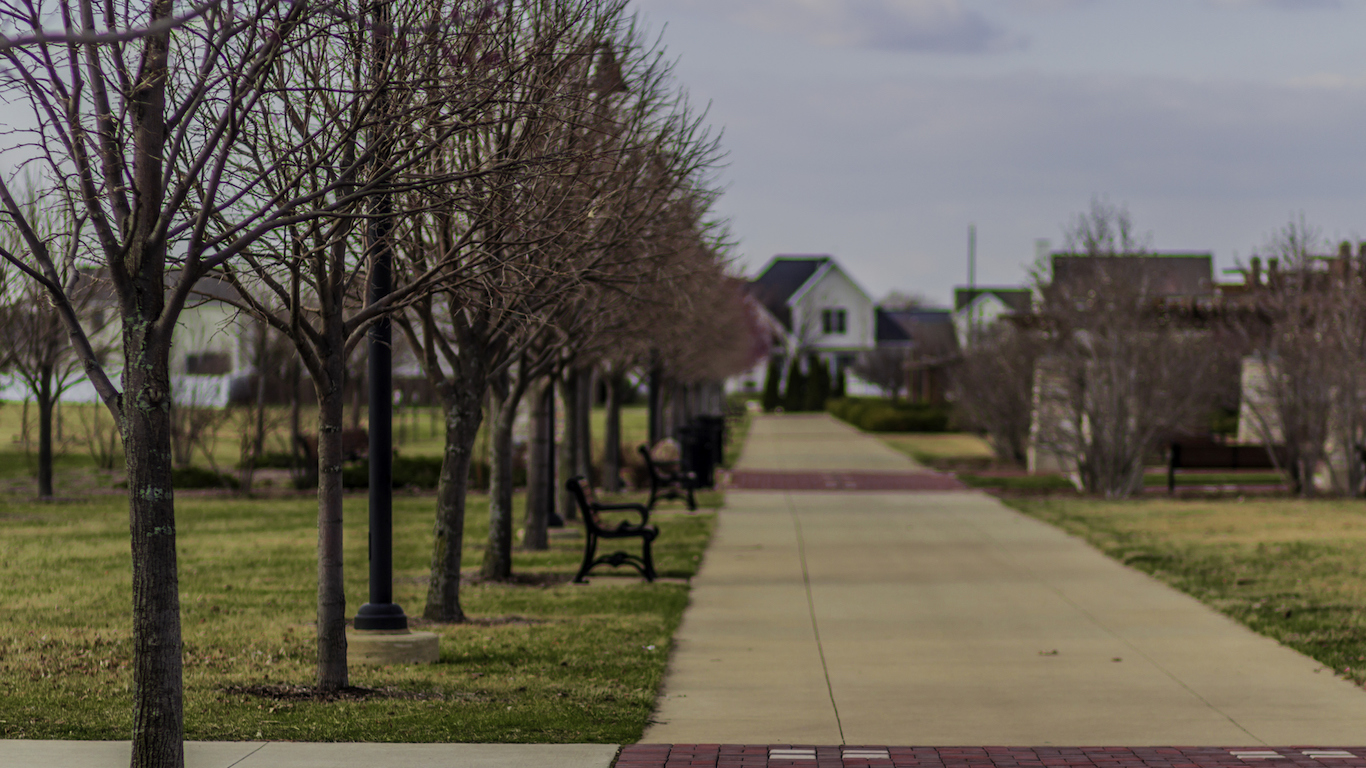
13. Bloomington, Illinois
> Premature death rate: 306.5 (per 100,000 residents)
> Adult obesity rate: 29.4%
> People under 65 without health insurance: 3.8%
> Median household income: $61,320
Individuals with health insurance coverage are more likely to make regular visits to the doctor and receive preventative medical care. In Bloomington, only 3.8% of the population under 65 is uninsured, a fraction of the statewide uninsured rate of 11.2% and the national rate of 10.3%.
Not only are people in Bloomington more likely to regularly visit a doctor than others in the state, but area adults are also less likely to smoke and more likely to exercise on a regular basis than adults in Illinois, as well as the country as a whole.
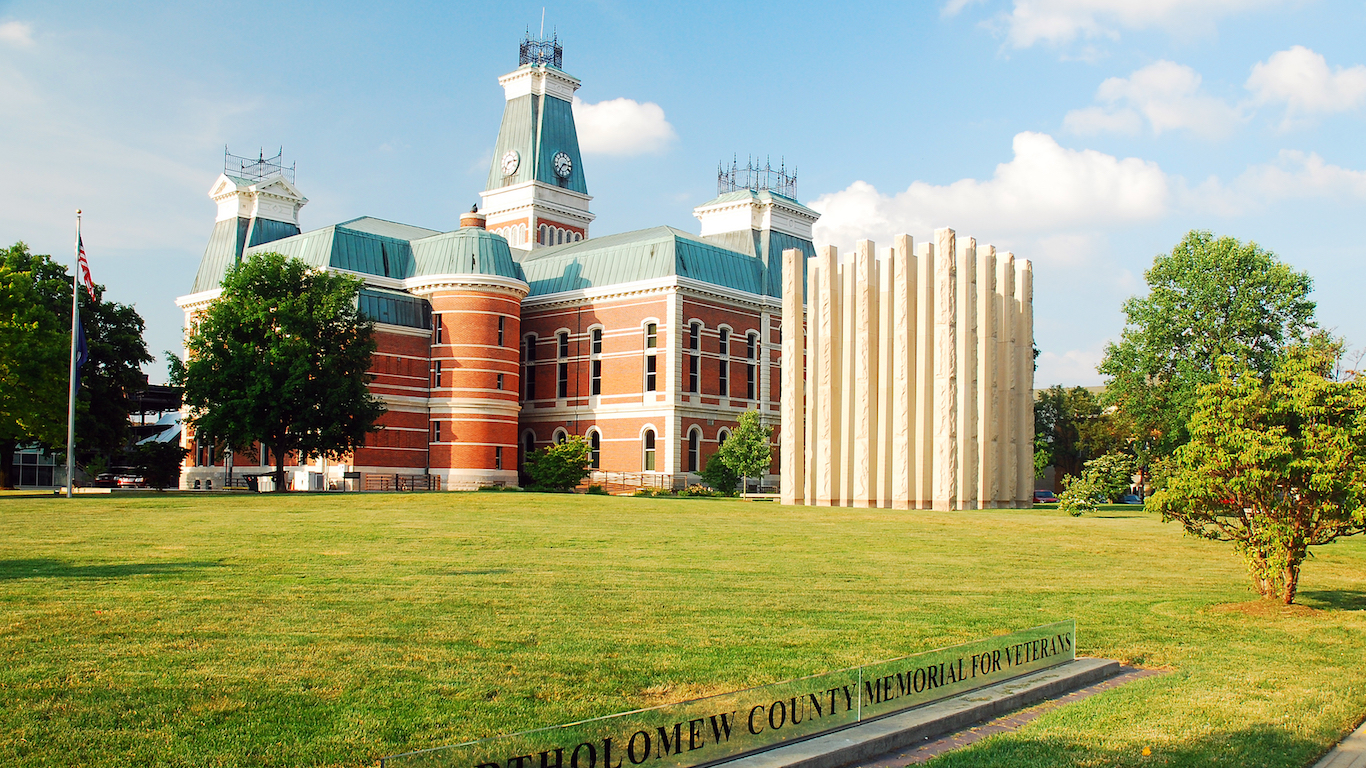
14. Columbus, Indiana
> Premature death rate: 370.2 (per 100,000 residents)
> Adult obesity rate: 29.5%
> People under 65 without health insurance: 9.3%
> Median household income: $59,102
The Columbus metro area population is generally healthier than the Indiana population as a whole. Some 14.0% of Columbus adults report having fair or poor health, 4 percentage points below Indiana adults. Columbus adults also average more than 0.5 fewer mentally and physically unhealthy days per month than adults in Indiana as a whole.
[in-text-ad-2]

15. Ames, Iowa
> Premature death rate: 240.3 (per 100,000 residents)
> Adult obesity rate: 27.1%
> People under 65 without health insurance: 2.8%
> Median household income: $53,371
One of the best indicators of health is the percentage of adults who say they feel healthy. In Ames, 11.8% of people say they are in just fair or poor health, versus the state and national percentages of adults reporting suboptimal health of 12.3% and 15.0 respectively.
Having health insurance can be a huge factor in staying healthy, as it allows people to seek preventive health care and treat any diseases. People under 65 in Ames, Iowa are more likely to have health insurance than anywhere else in the United States. Only 2.8% of people under 65 in Ames are uninsured, the lowest rate in the country and well below the national uninsured rate of 10.3%.
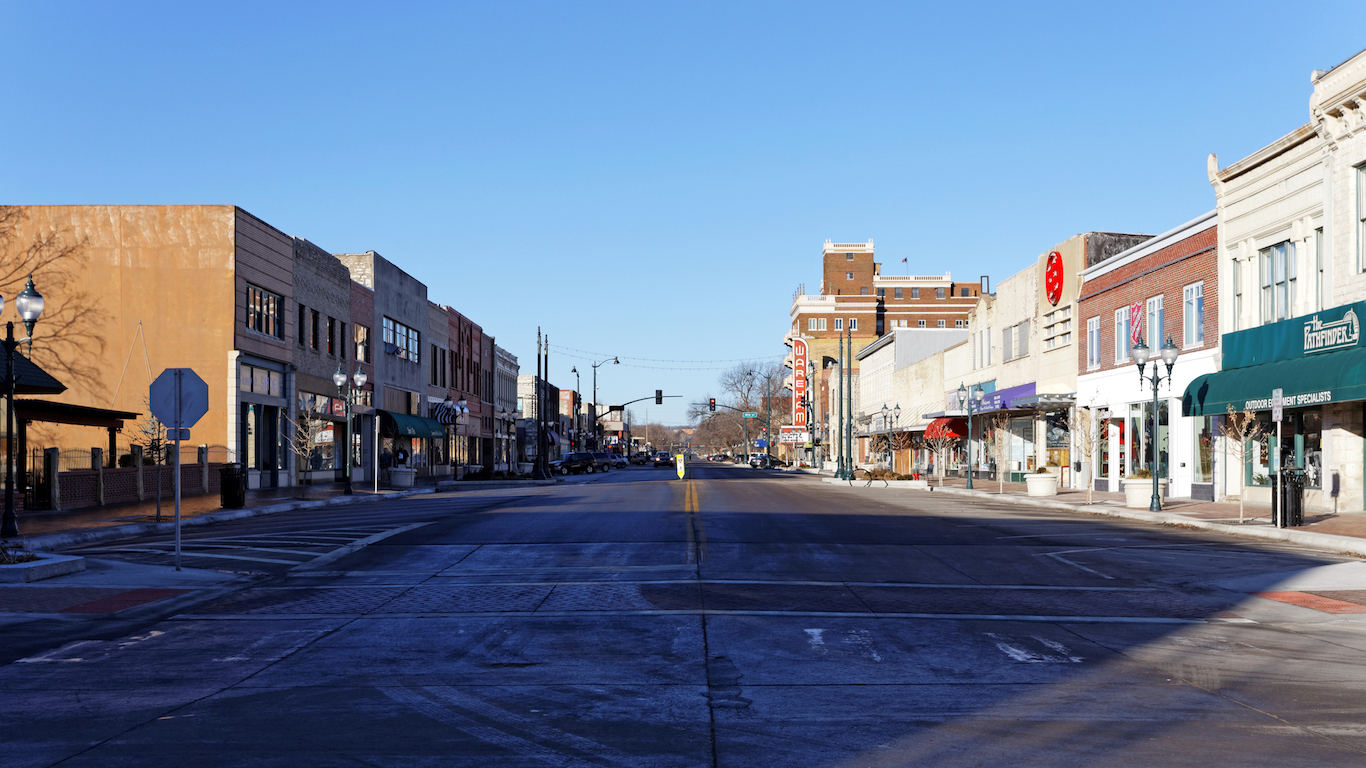
16. Manhattan, Kansas
> Premature death rate: 268.2 (per 100,000 residents)
> Adult obesity rate: 25.6%
> People under 65 without health insurance: 7.1%
> Median household income: $52,720
Only 15.8% of adults in the Manhattan, Kansas metro area report a smoking habit, and only 25.6% are obese — compared to 17.7% and 30.8% of adults statewide, respectively. Area residents’ healthier lifestyles likely contribute to the region’s more favorable health outcomes. For example, only 13.6% of area adults are in fair or poor health, below the 15.1% of adults statewide. Further, people in Manhattan are less likely to die prematurely of preventable causes than the typical Kansas resident and the typical American.
[in-text-ad]

17. Lexington-Fayette, Kentucky
> Premature death rate: 378.5 (per 100,000 residents)
> Adult obesity rate: 28.6%
> People under 65 without health insurance: 8.1%
> Median household income: $53,769
Kentucky is not an especially healthy state. Though by a number of lifestyle measures and health outcomes Lexington-Fayette ranks as the healthiest metro area in the state, area adults are relatively unhealthy compared to adults nationwide. They are more likely to smoke, be obese, and lead sedentary lives than the typical American.
Healthy behaviors and outcomes are more common among wealthier populations, and the typical Lexington-Fayette household earns $53,769 annually, below the U.S. median income of $57,617.

18. Baton Rouge, Louisiana
> Premature death rate: 443.7 (per 100,000 residents)
> Adult obesity rate: 33.8%
> People under 65 without health insurance: 10.6%
> Median household income: $52,487
A report from the CDC found that people who are better educated also tend to be healthier. Baton Rouge, Louisiana’s healthiest city, is case in point. The state of Louisiana, which has generally among the the worst health outcomes across its population, also has the fifth-lowest bachelor’s attainment rate.
Home to Louisiana State University, 26.9% of adults Baton Rouge have earned at least a bachelor’s degree, the second highest proportion in the state. While the state capital is not as healthy as many other state capitals, and in some cases has worse health outcomes compared to the country, its population is generally healthier than the state as a whole in areas like premature mortality.

19. Portland-South Portland, Maine
> Premature death rate: 283.1 (per 100,000 residents)
> Adult obesity rate: 24.7%
> People under 65 without health insurance: 9.2%
> Median household income: $63,422
Tobacco use is the leading cause of preventable death in the United States, and in the Portland-South Portland metro area, only 14.2% of adults are smokers — well below both the 19.5% and 18.0% state and national adult smoking rates.
Due in part to lower prevalence of some unhealthy habits, premature, preventable deaths are far less common in the Portland metro area than they are across both Maine and the United States. For every 100,000 people in the Portland area, there are 283 premature deaths a year, versus the state and national rates of 320 and 333 per 100,000 people.
[in-text-ad-2]

20. California-Lexington Park, Maryland
> Premature death rate: 321.0 (per 100,000 residents)
> Adult obesity rate: 32.0%
> People under 65 without health insurance: 4.0%
> Median household income: $78,195
Just 4.0% of people under the age of 65 in California-Lexington Park, Maryland do not have health insurance, less than half of the already-small 8.9% of people in Maryland without coverage and the 10.3% U.S. uninsured rate. Only 9.0% of area residents lack food security, meaning they do not have reliable access to the recommended amount of daily calories. This can lead to malnutrition, and obesity, which can each lead to a variety of negative long-term effects on health.

21. Boston-Cambridge-Newton, Massachusetts
> Premature death rate: 262.7 (per 100,000 residents)
> Adult obesity rate: 23.5%
> People under 65 without health insurance: 3.4%
> Median household income: $82,380
While it is not a perfect correlation, higher income households tend to have better health outcomes, thanks to the many advantages and opportunities afforded to more affluent individuals. In the Boston metro area, the typical household earns $82,380 a year, the most of any metro area in Massachusetts and well more than the median income nationwide of $57,617.
Boston area residents are less likely to report being in fair or poor health, less likely to be obese, more likely to have health insurance coverage, and less likely to die prematurely of preventable causes than the typical adult across both Massachusetts and the U.S. as a whole.
[in-text-ad]

22. Ann Arbor, Michigan
> Premature death rate: 256.0 (per 100,000 residents)
> Adult obesity rate: 24.4%
> People under 65 without health insurance: 4.8%
> Median household income: $65,601
Getting preventive care and treating illnesses early on can help improve health outcomes, but it is not always easy to find a doctor in some parts of the country. Fortunately for Ann Arbor, Michigan residents there is an abundance of doctors in the area. There are 175 primary care physicians per 100,000 residents in Ann Arbor, more than twice the national concentration of 76 primary care physicians per 100,000 people.
Among the area’s favorable health outcomes is one of the nation’s lowest obesity rates. Fewer than 25% of Ann Arbor adults are considered obese, versus the national obesity rate of nearly 30%.

23. Rochester, Minnesota
> Premature death rate: 226.1 (per 100,000 residents)
> Adult obesity rate: 26.1%
> People under 65 without health insurance: 4.4%
> Median household income: $70,078
Rochester, Minnesota residents are the healthiest in the state and one of the healthiest populations of any metro nationwide. Only 226.1 per 100,000 residents under the age of 75 die annually, a lower premature mortality rate than all but a few other U.S. cities.
With financial prosperity often comes the means to stay healthy. The median household in Rochester of $79,078 is well above the national median of $57,617. Rochester also has the second lowest rate of food insecurity and second lowest average number of mentally unhealthy days per month nationwide.

24. Jackson, Mississippi
> Premature death rate: 457.2 (per 100,000 residents)
> Adult obesity rate: 33.3%
> People under 65 without health insurance: 12.8%
> Median household income: $50,632
With a nation-worst premature death rate and an obesity rate of 35.2%, Mississippi is one of the least healthy states in the country. Even Jackson, the healthiest metro area in the state is not particularly healthy compared to the U.S. as a whole. For example, 33.3% of adults in Jackson are obese and 20.6% are in fair or poor health — far larger shares than the respective 28.0% and 15.0% of adults nationwide.
Health outcomes are closely tied to incomes, and the typical Jackson household earns only $50,632 a year. This is the highest median household income in Mississippi, but still well below the median American household income of $57,617.
[in-text-ad-2]

25. Columbia, Missouri
> Premature death rate: 293.0 (per 100,000 residents)
> Adult obesity rate: 28.4%
> People under 65 without health insurance: 6.5%
> Median household income: $52,752
Columbia performs much better than Missouri as a whole in a number of key health measures. Individuals with health insurance coverage are more likely to make regular doctor visits and receive preventative care. Just 6.5% of Columbia residents lack health insurance, less than half of Missouri’s uninsured rate of 13.7%. Columbia’s premature death rate of 293.0 deaths before age 75 per 100,000 residents is also below both the national premature death rate of 333.3 per 100,000 and the state rate of 386.4 per 100,000.

26. Missoula, Montana
> Premature death rate: 291.1 (per 100,000 residents)
> Adult obesity rate: 22.2%
> People under 65 without health insurance: 9.9%
> Median household income: $46,550
Some 22.2% of adults in Missoula, Montana are obese, several percentage points below the 25.0% state obesity rate and 28.0% national obesity rate.
Regular exercise, in addition to a healthy diet, can reduce the likelihood of obesity, and adults in Missoula are more likely to lead physically active lives than adults across the state and nation as a whole. Active lifestyles in the area are supported by access to venues for physical activities, like gyms and parks. An estimated 89.1% of Missoula residents have access to such places for exercise, compared to 84.0% of the U.S. population and 67.3% of people across the state.
[in-text-ad]

27. Lincoln, Nebraska
> Premature death rate: 271.2 (per 100,000 residents)
> Adult obesity rate: 26.2%
> People under 65 without health insurance: 8.3%
> Median household income: $59,344
Remaining physically active can be a critical component of a long and healthy life. In the Lincoln metro area, only 17.5% of adults lead inactive lives, well below the 21.5% share of adults across the state and 22.0% of adults nationwide. The tendency of area adults to exercise is likely encouraged by the presence of exercise venues. An estimated 93% of Lincoln metro area residents have easy access to places like parks, recreation centers, and gyms. In comparison, only about 80% of people in Nebraska and 84% of Americans nationwide have such access.
Healthy behaviors often lead to healthy outcomes and Lincoln has the lowest incidence of premature death of any metro area in Nebraska.
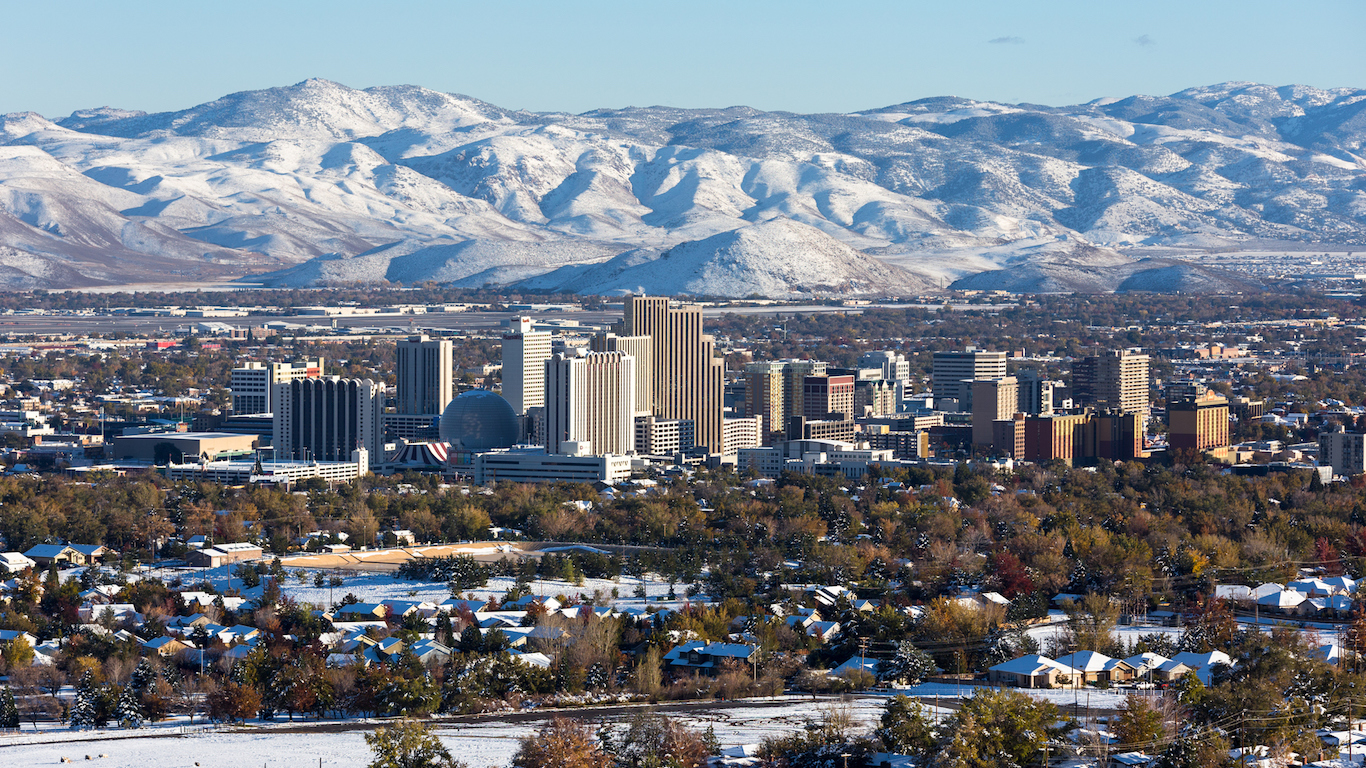
28. Reno, Nevada
> Premature death rate: 353.6 (per 100,000 residents)
> Adult obesity rate: 21.8%
> People under 65 without health insurance: 10.7%
> Median household income: $58,056
Some 10.7% of Reno, Nevada residents under 65 have no health insurance. Though that is higher than the national uninsured rate, it is well below Nevada’s. Some 17.3% of non-senior residents in Nevada have no health insurance. Reno residents also stay healthy by exercising. Some 84% of area adults lead physically active lives, compared to fewer than 80% of adults across the state and country as a whole.
Healthy behaviors often yield healthy outcomes. In Reno, only 14.8% of adults are in fair or poor health, the smallest share of any Nevada metro area and well below the 17.2% of adults statewide.

29. Manchester-Nashua, New Hampshire
> Premature death rate: 298.1 (per 100,000 residents)
> Adult obesity rate: 28.5%
> People under 65 without health insurance: 7.3%
> Median household income: $76,254
As the only metro area in New Hampshire, Manchester-Nashua is the healthiest by default. While in some measures of behaviors and outcomes Manchester residents are healthier than New Hampshire residents as a whole, in other important measures, the metro area falls behind the state as whole. For example, Manchester residents spend less time per month on average in poor mental or physical health than the typical New Hampshire resident. Similarly, only 11.0% of metro area adults are in fair or poor health compared to 11.5% of adults in the state.
Still, Manchester residents are more likely to be obese and more likely to die prematurely of preventable causes than the typical New Hampshire resident.
[in-text-ad-2]
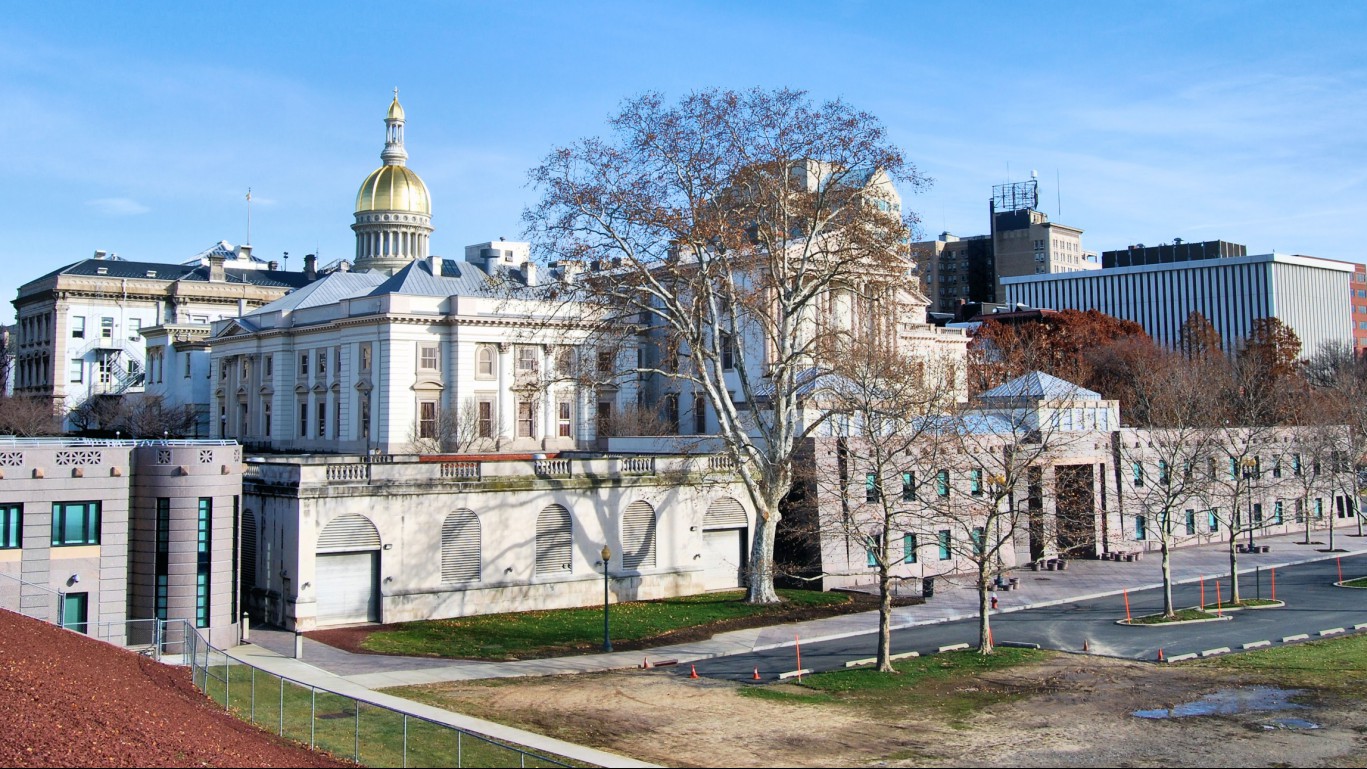
30. Trenton, New Jersey
> Premature death rate: 299.4 (per 100,000 residents)
> Adult obesity rate: 24.6%
> People under 65 without health insurance: 9.8%
> Median household income: $77,650
More people in Trenton, New Jersey have access to exercise venues than in almost any other major U.S. city. Some 97.2% of Trenton residents have access to places like gyms, parks, and recreation centers where they can engage in physical activity. Only 21.5% of area adults do not engage in physical activity, a smaller share than the 22.9% of adults in New Jersey and the 22.0% of American adults.
Trenton residents are also more likely than most to make regular doctor visits and receive preventative care. Only 9.8% of people in the metro area lack health insurance compared to 12.6% of New Jersey adults and 10.3% of American adults.

31. Santa Fe, New Mexico
> Premature death rate: 286.0 (per 100,000 residents)
> Adult obesity rate: 13.7%
> People under 65 without health insurance: 14.0%
> Median household income: $57,863
Obesity is linked with a number of serious health problems, but it is less likely for adults in Santa Fe, New Mexico to be obese than adults nationwide. Some 28.0% of Americans have a body mass index of 30 or above, which the definition of obesity in America. In Santa Fe, only 13.7% of adults are obese, by far the smallest share of any metro area in the state and less than half the comparable national rate.
Adults in Santa Fe are also less likely to smoke and more likely to regularly engage in physical activities than those in any other metro area in New Mexico. These factors, in addition to the area’s low obesity rate, likely contribute to the Santa Fe’s lowest in the state premature death rate of 286 deaths per 100,000 people annually. In comparison, there are 374 premature deaths per year for every 100,000 people across New Mexico as a whole.
[in-text-ad]

32. Ithaca, New York
> Premature death rate: 257.9 (per 100,000 residents)
> Adult obesity rate: 25.3%
> People under 65 without health insurance: 4.5%
> Median household income: $56,349
Teen pregnancies are associated with an increased risk of certain health problems for both the children and the mothers. Ithaca, New York has one of the lowest teen birth rates in the nation at 6.2 teen births per every 1,000 teenage girls. In addition, the premature death rate in the area is 257.9 per 100,000, well below the national rate of 333.3 premature deaths per 100,000.
Higher educational attainment typically leads to a greater sense of control over one’s life and healthier lifestyles and better outcomes. In Ithaca, 51.7% of adults have at least a bachelor’s degree, by far the largest share in the state and one of the largest shares of any U.S. metro area.
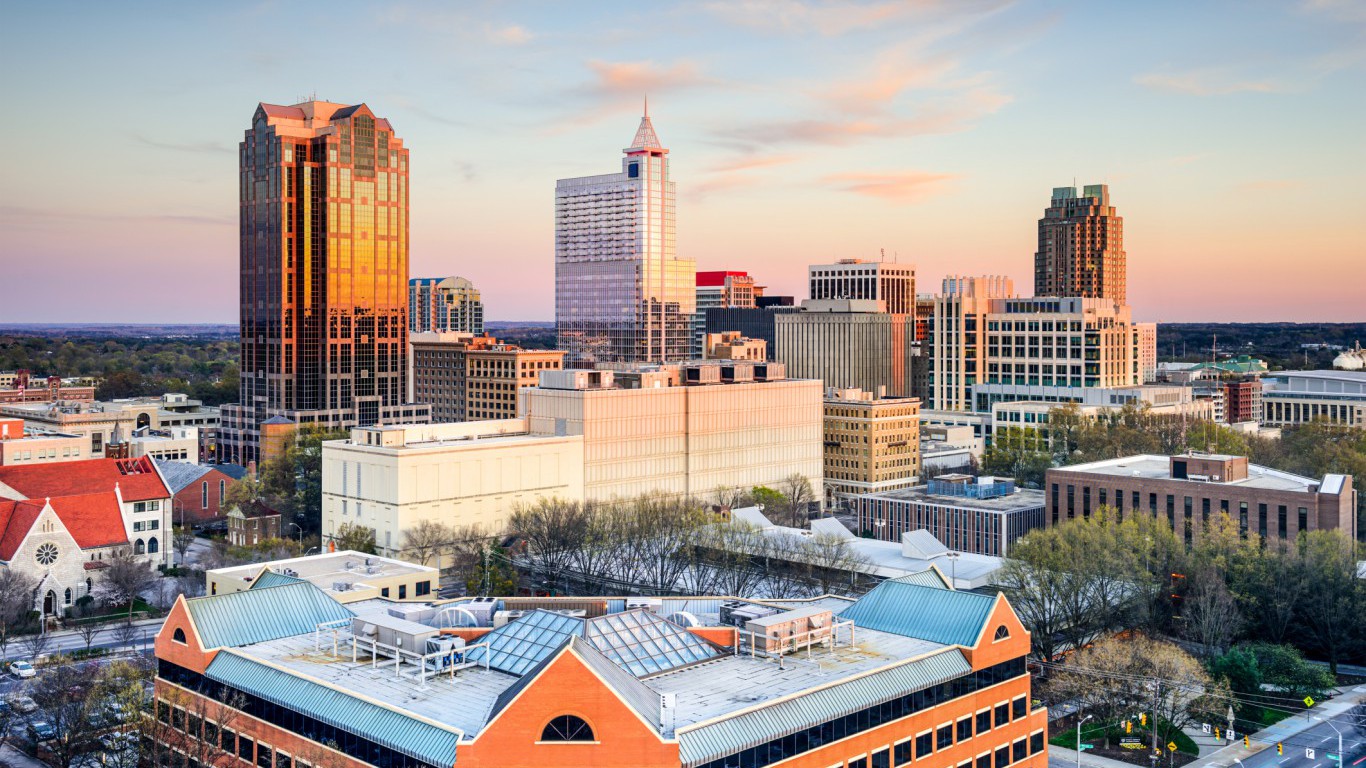
33. Raleigh, North Carolina
> Premature death rate: 276.1 (per 100,000 residents)
> Adult obesity rate: 26.7%
> People under 65 without health insurance: 10.1%
> Median household income: $71,685
By several measures of health outcomes, North Carolina is less healthy than the nation as a whole. Not all parts of the state are unhealthy, however. In the Raleigh metro area, only 14.0% of adults report being in fair or poor health, below both the statewide and nationwide share of 18.5% and 15.0% of adults, respectively.
Desirable health outcomes are often the result of healthy behaviors, and adults in the Raleigh metro area are less likely to smoke, more likely to exercise, and more likely to be covered by health insurance than both the typical American and North Carolinian adult.

34. Fargo, North Dakota
> Premature death rate: 291.8 (per 100,000 residents)
> Adult obesity rate: 28.9%
> People under 65 without health insurance: 6.3%
> Median household income: $60,009
Despite its cold weather, adults in Fargo, North Dakota are — by some measures — among the healthiest in the country. Adults in Fargo report an average of only 2.7 physically unhealthy days per month, the lowest rate in the United States. Similarly, only 11.5% of metro area adults are in fair or poor health, the smallest share of any metro area in the state and well below the 15.0% share of adults nationwide.
Favorable outcomes are partially the result of healthy behaviors. Fargo has the lowest smoking rate and the lowest obesity rate of any metro area in North Dakota.
[in-text-ad-2]

35. Columbus, Ohio
> Premature death rate: 365.8 (per 100,000 residents)
> Adult obesity rate: 30.5%
> People under 65 without health insurance: 7.9%
> Median household income: $60,294
Some 14.5% of adults in Columbus report being in fair or poor health, the smallest share of any Ohio metro area and below the 15.3% share of adults across the state. Adults in Columbus are also the most likely in the state get regular exercise.
Higher income individuals have a greater range of options when it comes to making healthy choices. As a result, higher income areas often report better health outcomes. In Columbus, the typical household earns $60,294, the highest median income of any Ohio metro area.

36. Oklahoma City, Oklahoma
> Premature death rate: 428.2 (per 100,000 residents)
> Adult obesity rate: 31.7%
> People under 65 without health insurance: 14.5%
> Median household income: $55,065
Only 18.1% of adults in Oklahoma City smoke, well below the 22.2% statewide smoking rate. Adults in the metro area are also less likely to be obese and more likely to exercise than the typical adult across the state.
Better educated populations tend to report better health outcomes. In Oklahoma City, the healthiest metro area in the state, about 30% of adults have at least a bachelor’s degree. In comparison, only 25% of adults across Oklahoma have a four-year college degree.
[in-text-ad]
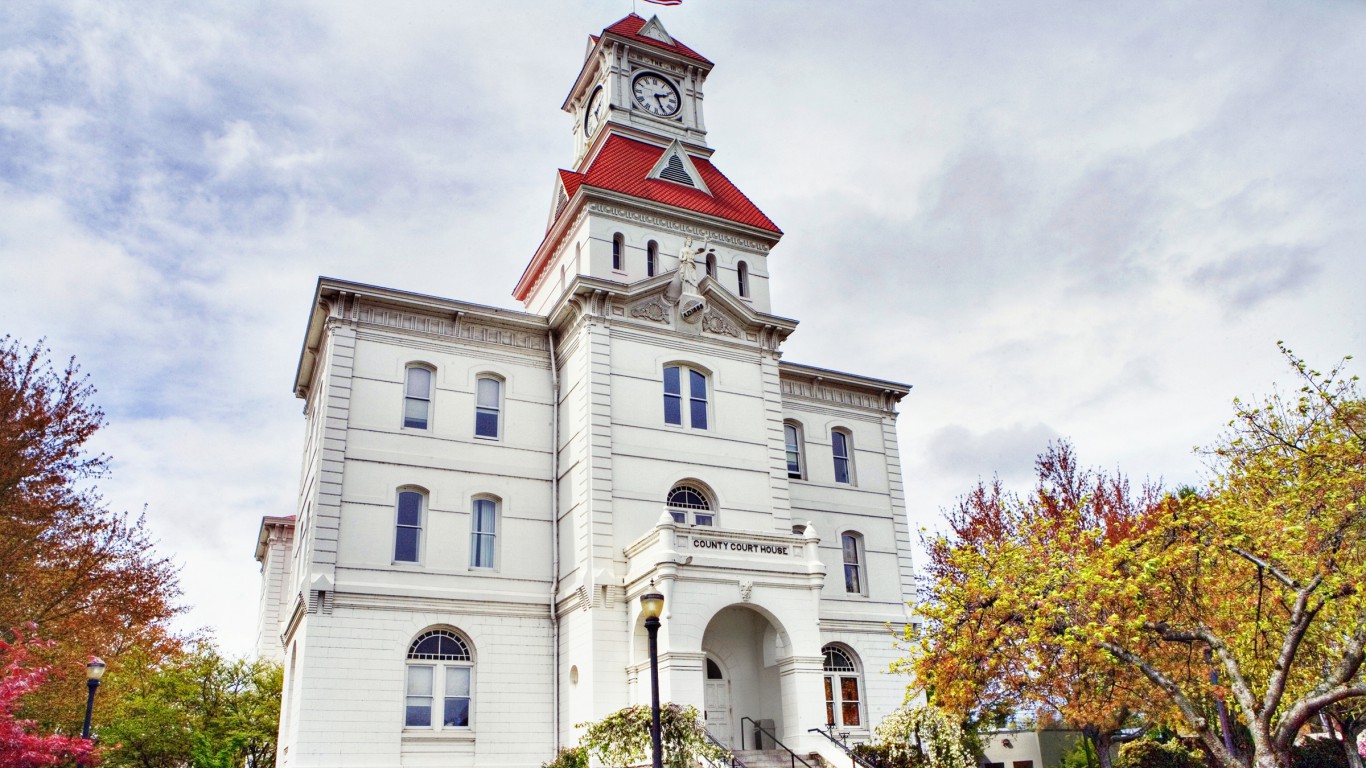
37. Corvallis, Oregon
> Premature death rate: 217.5 (per 100,000 residents)
> Adult obesity rate: 21.6%
> People under 65 without health insurance: 6.2%
> Median household income: $55,459
Low birthweight is a serious and increasingly common health risk for newborn babies. Children born weighing under 5 pounds, 8 ounces are at a greater risk of complications like infection and difficulty breathing. Fortunately, Corvallis, Oregon has one of the lowest instances of low birthweights. Only 5.3% of babies born in Corvallis are considered underweight compared to 8.0% of babies born nation wide.
The metro area also boasts the lowest smoking rate and the lowest obesity rate of any metro area in Oregon. Each of these factors may partially explain why Corvallis’ premature death rate of 218 deaths before age 75 per 100,000 people per year is lowest premature death rate in the state.

38. State College, Pennsylvania
> Premature death rate: 213.5 (per 100,000 residents)
> Adult obesity rate: 26.6%
> People under 65 without health insurance: 6.5%
> Median household income: $60,266
State College, Pennsylvania has the lowest teen birth rate of any metro area in the nation. There are only 5.1 teen births per every 1,000 teenage girls annually, a fraction of the 32.0 per 1,000 teen birth rate nationwide. State College also has the third lowest premature death rate of any metro area nationwide at 213.5 per 100,000 residents.
Better educated populations often report better than average health outcomes, and State College is no exception. Some 48.3% of area adults have at least a bachelor’s degree, well above the 30.8% share of Pennsylvania adults and the 31.3% share of American adults.

39. Providence-Warwick, Rhode Island
> Premature death rate: 316.0 (per 100,000 residents)
> Adult obesity rate: 27.5%
> People under 65 without health insurance: 5.6%
> Median household income: $61,948
As the only metro area in Rhode Island, Providence is the healthiest by default. In many ways, residents of Rhode Island’s capital city are less healthy than the state population as a whole. For example, some 23.7% of adults in Providence get no exercise beyond getting up and going to work, a larger share than the 22.9% share of adults statewide. Additionally, both Providence’s smoking and obesity rates are slightly higher than the corresponding rates statewide.
Such unhealthy behaviors may partially explain why there are 316 premature deaths for every 100,000 people in the metro area per year, more than the comparable statewide rate of 303 deaths per 100,000.
[in-text-ad-2]

40. Hilton Head Island-Bluffton-Beaufort, South Carolina
> Premature death rate: 284.5 (per 100,000 residents)
> Adult obesity rate: 24.0%
> People under 65 without health insurance: 17.0%
> Median household income: $63,756
The Hilton Head Island-Bluffton-Beaufort area is well ahead of South Carolina as a whole in a number of crucial health indicators. The area’s annual premature mortality rate of 284.5 deaths per 100,000 people is much lower than the state rate of 404.7 premature deaths per 100,000 people. Some 15.1% of area adults smoke cigarettes compared to 19.7% of South Carolinian adults. Also, just 24.0% of adults in Hilton Head are obese, compared to 31.8% of adults across the state.
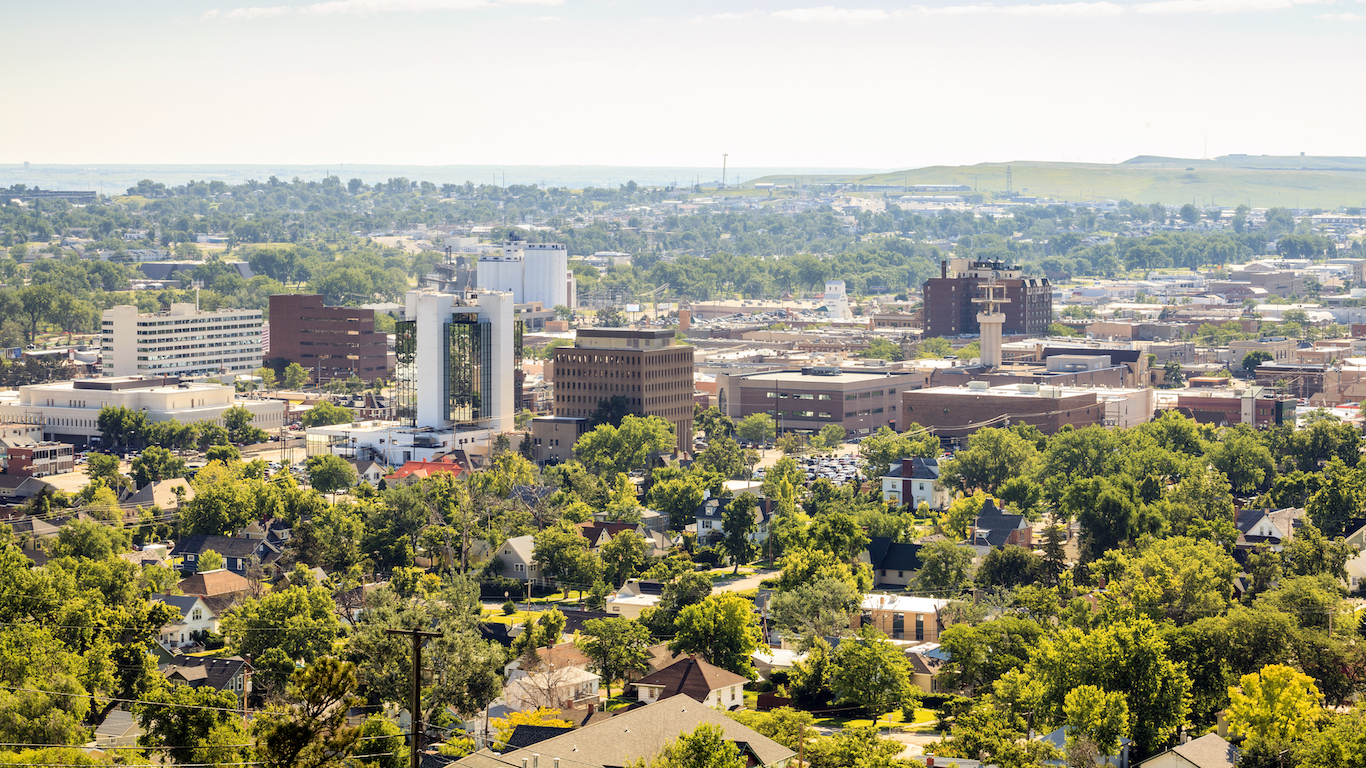
41. Rapid City, South Dakota
> Premature death rate: 297.2 (per 100,000 residents)
> Adult obesity rate: 27.4%
> People under 65 without health insurance: 15.1%
> Median household income: $51,097
While North Dakota adults report the fewest average physically unhealthy days a month, South Dakota adults report the fewest mentally unhealthy days a month of any state. South Dakotan adults report an average of 2.5 mentally unhealthy days a month. Although Rapid City adults report a slightly higher average of 2.8 mentally healthy days per month, it is still far fewer than the national average of 3.7 mentally unhealthy days per month.
Of the state’s two metro areas, Rapid City has the lowest rate of babies born with a low birth weight, at just 6.7%. That is below the national rate of 8.0%, but a bit higher than South Dakota’s rate of low birth weights, which is 6.3% — one of the lowest such rates of any state.
[in-text-ad]

42. Nashville-Davidson-Murfreesboro-Franklin, Tennessee
> Premature death rate: 387.4 (per 100,000 residents)
> Adult obesity rate: 31.3%
> People under 65 without health insurance: 11.0%
> Median household income: $60,030
Tennessee lags behind much of the rest of nation in a number of critical health measures. Even Nashville, the healthiest metro area in the state, is less healthy than the U.S. as a whole. Some 17.0% of metro area adults report being in fair or poor health, lower than the 19.9% statewide share but higher than the 15.0% share of American adults.
The unhealthy outcomes in the metro area may be a product of some relatively common unhealthy habits. For example, adults in Nashville are less likely to exercise and more likely to smoke than the typical American adult.

43. Austin-Round Rock, Texas
> Premature death rate: 260.0 (per 100,000 residents)
> Adult obesity rate: 24.0%
> People under 65 without health insurance: 14.1%
> Median household income: $71,000
Adults in the Austin-Round Rock area of Texas are less likely to smoke than adults statewide and nationwide. Some 13.2% of adults in Austin smoke, compared to 15.2% of Texans and 18.0% of Americans overall. Also, just 16.1% of area adults report getting no leisure time physical activity, a much smaller share than the 23.0% of adults in Texas and the 22.0% of American adults who get no exercise in their leisure time.

44. Provo-Orem, Utah
> Premature death rate: 255.3 (per 100,000 residents)
> Adult obesity rate: 24.5%
> People under 65 without health insurance: 10.2%
> Median household income: $69,288
Only 11.3% of adults in the Provo-Orem metro area are in fair or poor health, the smallest share of any metro area in the state. Provo-Orem, Utah likely owes much of its status as a healthy city to clean living, as so few of its residents have unhealthy vices. Just 6.6% of Provo-Orem adults smoke cigarettes, about 2 percentage points lower than the next closest metro area in the state and far below the national smoking rate of 18.0%. Additionally, at only 8.5%, the Provo-Orem metro area also has the the nation’s lowest excessive drinking rate.
[in-text-ad-2]

45. Burlington-South Burlington, Vermont
> Premature death rate: 279.8 (per 100,000 residents)
> Adult obesity rate: 21.8%
> People under 65 without health insurance: 3.6%
> Median household income: $66,367
People feel better in Burlington-South Burlington, Vermont than anywhere else in the country. Just 9.1% of the metro area’s adults report feeling in either fair or poor health, the lowest rate in the country. That is several percentage points lower than the national share of people feeling fair or poor of 15.0%. People in the Burlington area also tend to be sick fewer days on average, with an average of just 2.9 physically unhealthy days per month. That’s nearly the lowest rate of any metro area in the U.S. and well below the 3.6 unhealthy day average per month nationwide.

46. Charlottesville, Virginia
> Premature death rate: 289.7 (per 100,000 residents)
> Adult obesity rate: 25.6%
> People under 65 without health insurance: 10.0%
> Median household income: $62,523
As educational attainment goes up, the sense of control over one’s life often does too. Additionally, people with higher education are more likely to lead long, healthy lives than those with only a basic education. In Charlottesville, 44.5% of adults have at least a bachelor’s degree, nearly the largest share of any metro area in the state and well above the 38.1% of adults in Virginia and the 31.3% of adults nationwide.
Adults in Charlottesville are also less likely to smoke, less likely to be obese, and more likely to exercise than both the typical adult in the state and the typical American adult.
[in-text-ad]

47. Seattle-Tacoma-Bellevue, Washington
> Premature death rate: 270.9 (per 100,000 residents)
> Adult obesity rate: 25.5%
> People under 65 without health insurance: 6.7%
> Median household income: $78,612
The Seattle area reports one of smallest rates low birth weights among U.S. metro areas. Just 6.4% of babies in the area were born underweight compared to the 8.0% national rate of underweight babies. The rate in Washington state is even lower, at 6.3%. Additionally, the teen birth rate in the metro area is 19.5 teen births per every 1,000 teenage girls, far lower than the state rate of 25.6 births and nationwide rate of 32.0 births per 1,000 teenage girls.
Additionally, only 11.4% of adults in the Seattle metro area are in fair or poor health and 11.7% of area adults are smokers, each the smallest such shares of any metro area in the state.

48. Morgantown, West Virginia
> Premature death rate: 348.3 (per 100,000 residents)
> Adult obesity rate: 30.5%
> People under 65 without health insurance: 4.6%
> Median household income: $50,120
West Virginia is one of the least healthy states in the country, and even Morgantown, the healthiest metro area in the state, is relatively unhealthy. Nearly 20% of metro area adults report being in fair or poor health, fewer than the 24% of adults across the state, but far more than the 15% share of adults nationwide.
People facing serious financial hardship are less likely to be able to afford healthy food and quality health care. More than 1 in every 5 residents live below the poverty line in Morgantown, far more than the 14.0% share of Americans nationwide.
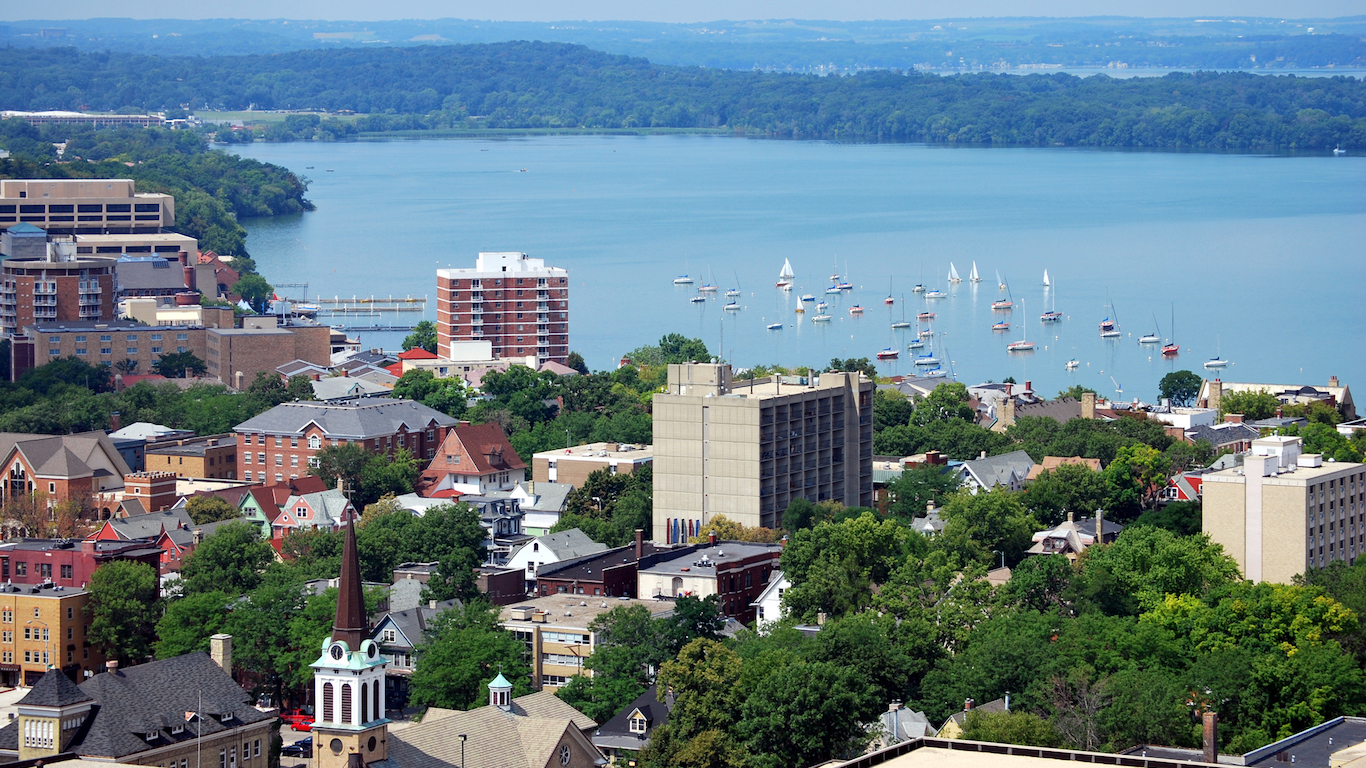
49. Madison, Wisconsin
> Premature death rate: 251.2 (per 100,000 residents)
> Adult obesity rate: 25.4%
> People under 65 without health insurance: 5.0%
> Median household income: $68,497
Higher earning, better-educated populations are more likely to be in good health than lower earning and less educated populations. In Madison, the typical household earns $68,497 a year, and 46.6% of adults have a bachelor’s degree or higher — each the largest such shares of any metro area in Wisconsin.
Only 11.5% of adults in Madison report being in fair or poor health, well below the 14.0% statewide share and the 15.0% nationwide share.
[in-text-ad-2]

50. Cheyenne, Wyoming
> Premature death rate: 340.0 (per 100,000 residents)
> Adult obesity rate: 29.7%
> People under 65 without health insurance: 12.9%
> Median household income: $62,221
Wyoming has just two metro areas, Casper and Cheyenne, and Cheyenne rated slightly better than Casper in several health indicators. The low population density in the state presents some obstacles for healthy living. Just 63.0% of Cheyenne residents have a place where they can go to exercise, which is far below the 84.0% national rate. Physical exercise is a key component of a healthy lifestyle and people may be discouraged from exercising if they don’t have a convenient place to work out.
However, Cheyenne ranked as the top metropolitan area in Wyoming in a number of key health indicators, including the lowest rate of mentally unhealthy days, the smallest percentage of adults who drink excessively, and the lowest rate of adults who report being in fair or poor health.
Detailed Findings & Methodology
Much of the index used to rank the healthiest city in each state is based on healthy behaviors, such as getting enough exercise. Working out on a regular basis can help reduce the risk of cardiovascular disease, diabetes, and even some types of cancer.
The ranking also factors in the percentage of the adult population who smokes cigarettes. Smoking causes lung cancer and pulmonary disease and increases the risk of a range of other diseases. Smoking is responsible for over 480,000 deaths annually in the United States, according to the Centers for Disease Control and Prevention.
Because exercising and smoking can affect health outcomes, populations that tend to exercise more and smoke less tend to be healthier. There are other indicators that correlate to the rankings of healthiest cities that have nothing to do with health.
Populations that are better educated tend to be healthier on average. Cities with the healthiest populations also tend to have the highest educational attainment rate among cities in the state. Many of them, such as Columbus, Ohio, and Columbia, Missouri are home to large state universities which likely contributes to the higher educational attainment in those cities.
Wealth is also correlated with health in these cities. Medical care in the United States can often be expensive. People who live in metro areas with higher median household incomes are more likely to afford care and treat any looming health problems more effectively.
To identify the healthiest city in every state, 24/7 Wall St. created an index modelled after an analysis conducted by County Health Rankings & Roadmaps, a Robert Wood Johnson Foundation and University of Wisconsin Population Health Institute joint program. The index rankings are based on overall health outcomes, a weighted composite of length of life, quality of life, and overall health factors. The health factors component is itself a weighted composite of healthy behaviors, clinical care, social and economic factors, and physical environment measures. All data used are for the most recent available year. The index was used to compare all U.S. metropolitan statistical areas as defined by the U.S. Census Bureau.
The thought of burdening your family with a financial disaster is most Americans’ nightmare. However, recent studies show that over 100 million Americans still don’t have proper life insurance in the event they pass away.
Life insurance can bring peace of mind – ensuring your loved ones are safeguarded against unforeseen expenses and debts. With premiums often lower than expected and a variety of plans tailored to different life stages and health conditions, securing a policy is more accessible than ever.
A quick, no-obligation quote can provide valuable insight into what’s available and what might best suit your family’s needs. Life insurance is a simple step you can take today to help secure peace of mind for your loved ones tomorrow.
Click here to learn how to get a quote in just a few minutes.
Thank you for reading! Have some feedback for us?
Contact the 24/7 Wall St. editorial team.